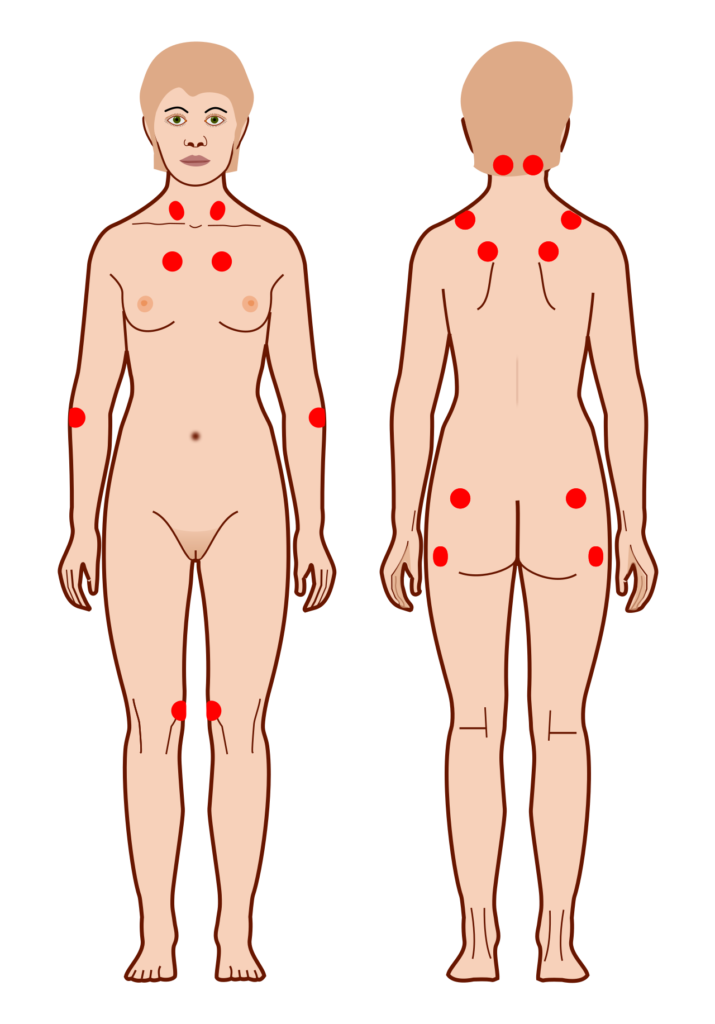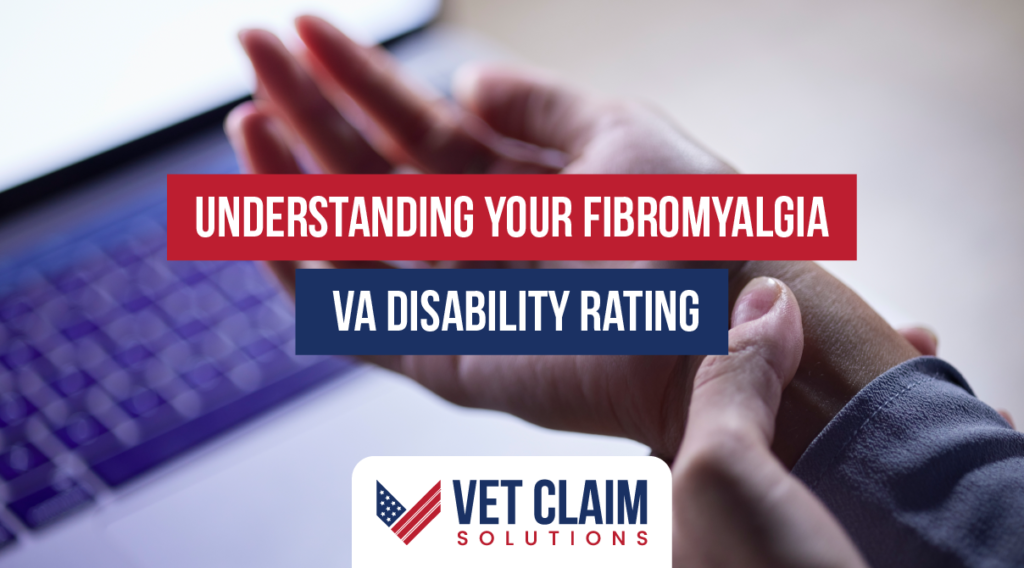Ever felt like you’re wrestling with an invisible opponent? That’s how many veterans describe living with Fibromyalgia – a relentless, unseen adversary causing unexplained pain.
Frustratingly elusive to diagnose and often misunderstood, this condition can make life feel like a battlefield. Envision a struggle for acknowledgement that doesn’t have to be so demanding?
Imagine navigating the VA system confidently, understanding exactly how your Fibromyalgia is rated. Picture being equipped with knowledge about service-related connections, especially for Gulf War veterans. And ladies in uniform? We’ve got something for you too as we delve into why women are more susceptible.
The stakes are high but don’t fret; we’re about to unlock these mysteries together! Ready to enlist in your own health advocacy journey?
Understanding Fibromyalgia: A Neurological Condition

Fibromyalgia, a complex neurological condition, often baffles both patients and medical professionals alike. It’s known for causing widespread musculoskeletal pain, but the real challenge lies in its elusive nature.
The Elusive Nature of Fibromyalgia Diagnosis
Fibromyalgia doesn’t show up on x-rays or blood tests, making it notoriously hard to diagnose. Instead, doctors rely on patient symptoms and physical exam findings. For example, if you feel pain when firm pressure is applied to certain areas of your body – these are known as tender points.

Diagnosing fibromyalgia isn’t about checking boxes; it’s more like putting together a jigsaw puzzle without having the picture on the box top. The process involves ruling out other potential causes before finally landing at this diagnosis.
According to research data, nearly 5 million Americans have been diagnosed with this condition, which indicates that fibromyalgia is not rare at all.
The Challenges in Treatment
Treatment for fibromyalgia also comes with challenges due to its multifaceted nature. No single therapy is successful for all–it’s usually a blend of medications, exercise, stress-reduction approaches, and healthy lifestyle practices to help regulate signs.
Finding the right treatment for a condition can be compared to finding the correct key that fits into a lock. And while some people may need only over-the-counter pain relievers, others might require prescription drugs for symptom management.

The journey with fibromyalgia is often more of a marathon than a sprint. But don’t lose hope. Despite its complexities and challenges, understanding your condition better can empower you to seek out effective treatments and regain control over your life.
VA Ratings for Fibromyalgia
The VA rates Fibromyalgia on a scale of 10%, 20%, or 40% depending on the severity. A disability rating of 10%, 20% or 40% will be given depending on the effect Fibromyalgia has had on your daily life.
Understanding the VA Rating Scale for Fibromyalgia

A disability rating of 10%, given by VA, signifies that you have mild symptoms controlled by continuous medication. Your capability to work is not greatly hampered and you are able to perform most activities without too much pain.

If your symptoms are more persistent and unresponsive to treatment, causing interference with physical activity despite taking medication continuously, you might receive a 20% rating. This means that even though you can still manage some form of employment, fibromyalgia is having a moderate effect on your everyday routine.

The highest score – 40% – indicates severe constant pain affecting multiple areas in addition to other debilitating signs such as fatigue or sleep disturbances which significantly limit one’s capacity for gainful employment or perform normal daily tasks effectively.
This ratings system may seem straight-forward but it can become complicated when combined with other conditions related to service-connected disabilities. For example: If two different disabilities each rate at 50%, their cumulative effect doesn’t add up straightforwardly to 100%. Adding the two disabilities together does not yield a straightforward result. Rather, the VA uses a combined rating table that considers how multiple disabilities impact one’s overall health.
At Vet Claim Solutions, we’ve got your six when it comes to navigating this complex process. Our experienced team can help you get an accurate diagnosis and connect your fibromyalgia with military service, making sure you receive all of the benefits owed to you by Uncle Sam. After all, maximizing your VA disability rating is what we’re here for.
Key Takeaway:
The VA rates fibromyalgia on a scale of 10%, 20%, or 40% based on the severity and impact it has on your daily life. This rating system can get tricky when mixed with other service-connected disabilities, but at Vet Claim Solutions, we’re here to help you navigate this process and make sure you receive all benefits owed.
Gulf War Veterans and Fibromyalgia

As Gulf War veterans, you’re more than heroes; you’re survivors. But sometimes, the battle continues even after returning home – like with fibromyalgia. This is a complex condition that causes widespread pain and fatigue.
Fibromyalgia isn’t picky; it affects both men and women alike. Yet for some reason, the VA has noticed an increased prevalence among Gulf War vets. Statistically speaking, key stats 7 & 8 reveal a higher rate of diagnosis in this group compared to others.
This has led researchers to wonder: Is there something about serving in the Gulf War specifically that could trigger fibromyalgia? Or does military service in general increase risk?
The Presumed Connection Between Service And Condition
A presumption exists within VA law regarding certain conditions – including fibromyalgia – if they manifest themselves to a degree of at least 10% within one year from active duty end date. It’s sort of like when your car starts making strange noises right after its warranty expires — no specific cause can be pointed out, but we know where to look first.
In essence, if you served during the Gulf War era (from August 1990 onwards), have been diagnosed with fibromyalgia post-service, and meet certain criteria, you don’t need further proof connecting your service with this condition. This might sound confusing, but think of it as having VIP access—you get through quicker because everyone already knows who you are.

Gulf War veterans diagnosed with post-service fibromyalgia may qualify without additional proof, given they meet specific criteria.
The Role Of Stress In Triggering Fibromyalgic Symptoms
One hypothesis suggests that the strain of military service may be a factor in causing fibromyalgia. Stress can make your body react in funny ways, like how some people get hives before public speaking.
Think of the stereo. Just like cranking up the volume makes every note more intense, stress amplifies your body’s pain signals. So in fibromyalgia, even a slight touch can feel incredibly painful.
Key Takeaway:
If you’re a Gulf War vet, dealing with fibromyalgia can feel like another battle. It’s a painful condition that hits your group hard. But there’s good news – the VA has your back. They see the link between service and symptoms showing up within one year of ending duty, which makes it easier for you to get help without having to prove how your service is connected.
Women and Fibromyalgia
Fibromyalgia is an invisible adversary, causing widespread pain throughout the body. It’s like a cruel game of hide-and-seek, with discomfort lurking in unexpected places. But here’s the kicker: women are more likely to be “it”. Nearly 90% of fibromyalgia sufferers are female according to this study.

This condition doesn’t play fair either. It stacks the deck against some ladies by teaming up with other conditions such as rheumatoid arthritis, lupus, and osteoarthritis – making their lives even tougher.
Risk Factors for Women

The question that puzzles many is why women bear this burden disproportionately? Part of it may come down to hormones – those powerful chemicals coursing through our bodies influencing everything from mood swings to metabolism.
Estrogen’s influence on pain perception may explain why more women experience fibromyalgia, potentially due to genetic factors inherited from their parents.
It’s also possible that genetic factors could have something to do with it too. Like passing on mom’s eyes or dad’s sense of humor, susceptibility towards developing fibromyalgia might be another thing you get from your folks.
The Triple Threat: Rheumatoid Arthritis, Lupus & Osteoarthritis
Sometimes bad things come in threes. And when it comes to health issues faced by women suffering from Fibromyalgia they often deal not only with its wide-ranging symptoms but also rheumatoid arthritis (RA), lupus and osteoarthritis(OA).

Rheumatoid Arthritis: Women with RA are more likely to develop fibromyalgia. The body’s immune system mistakenly attacks its own tissues, causing painful swelling and damage.

Lupus: Another autoimmune disease that can coincide with fibromyalgia is lupus. It affects many parts of the body including joints, skin, kidneys, blood cells, brain, heart and lungs.

Osteoarthritis: Osteoarthritis is a joint disorder marked by cartilage degeneration, causing pain and stiffness. It commonly affects weight-bearing joints and becomes more prevalent with age. Though incurable, treatments aim to alleviate symptoms through lifestyle adjustments, medications, and, in some cases, surgery.
Key Takeaway:
Fibromyalgia, a widespread pain condition, unfairly targets women with nearly 90% of sufferers being female. This might be due to hormonal or genetic factors. Adding insult to injury, it often partners up with other conditions like rheumatoid arthritis, lupus and osteoarthritis – forming a tough-to-tackle triple threat for these ladies.
Diagnosing Fibromyalgia in Veterans
Fibromyalgia, a neurological disorder marked by generalized pain and weariness, can be hard to identify. But for veterans dealing with this elusive illness, understanding the diagnostic process can make all the difference when submitting disability claims.

A common method used to detect fibromyalgia involves assessing specific tender points throughout the body. This method, however, has its shortcomings since symptoms may differ between people and can even fluctuate within the same individual. Therefore, physicians have adopted more comprehensive methods like examining symptom history and ruling out other conditions that could cause similar discomforts.
During a VA Compensation & Pension (C&P) exam, doctors apply these same principles but also consider factors unique to veterans’ experiences. For instance, Gulf War vets are presumed service-connected for fibromyalgia due to their potential exposure to hazardous materials during service.
The Role of Medical Evidence in Diagnosis
In order for veterans suffering from fybromaliga’s wide-ranging effects – chronic muscle pain, extreme fatigue or cognitive issues known as ‘fibro fog’ – to get recognized by the VA, they need substantial medical evidence showing consistent symptoms over time.
- An extensive medical history documenting recurring instances of unexplained musculoskeletal pain across multiple regions of your body.
- Medical records showing the exclusion of other conditions that could be causing your symptoms.
- Evidence demonstrating how fibromyalgia affects daily activities or work ability. This is vital in determining a disability rating, which can range from 10% to 40% based on severity.
Beyond these steps, making sure you’ve communicated clearly with your healthcare provider about all your symptoms and concerns will strengthen your claim. Remember, this isn’t just a medical process; it’s also an advocacy journey where being proactive pays off.
Assistance for Veterans with Fibromyalgia

Fibromyalgia, a persistent pain condition, can be particularly challenging for veterans. At Vet Claim Solutions, we understand these challenges and are committed to helping veterans get the VA disability benefits they deserve.
We know that navigating through the VA system isn’t easy. It’s like trying to find your way in a dense forest without a map or compass – you could easily lose your direction. But don’t worry. Our team at Vet Claim Solutions, is here to guide you on this journey.
The Support You Need
We believe no veteran should fight alone when it comes to their health and well-being. That’s why our mission is clear: give veterans help with denied claims, rejected service-related connections or lower disability ratings related to fibromyalgia. According to data from 2023, around 10% of all U.S military vets suffer from fibromyalgia – showing just how vital support services are.
Veterans often face obstacles when seeking assistance due their unique circumstances – but think of us as your personal GPS device guiding you past those roadblocks towards successful claims submission.
A Personalized Approach

To us, every case is different—just like snowflakes in winter; each one has its own pattern. We analyze individual cases meticulously and craft strategies tailored specifically for them using our expertise built over years working with similar situations. In fact, according statistical evidence, successful appeals by experienced representatives increased claim success rates by nearly 82%.
Transparency and Trust
We understand the value of trust in our line of work. We strive to ensure that you are kept abreast of the progress of your claim at all times, providing a seamless experience akin to tracking a pizza delivery. You can track progress on our secure online platform – just like tracking your pizza delivery.
Our team isn’t just made up of experts. We’re also proud to include veterans who have personally navigated the VA system.
Key Takeaway:
With Vet Claim Solutions, we’re on a mission to make sure veterans battling fibromyalgia get the VA disability benefits they rightly deserve. We understand that working your way through the VA system can feel like getting lost in an uncharted forest with no map or compass for guidance. But don’t worry. Consider our team as your personal GPS, guiding you smoothly past any roadblocks and towards successful claim submission.
Fibromyalgia and Other Service-Related Conditions
Navigating life with Fibromyalgia can be hard, yet what does one do when it’s only a single one of multiple service-related ailments for a veteran to contend with? This is a common occurrence among veterans who have served in the military. Many veterans have multiple medical issues stemming from their service in the military.
The VA recognizes this reality and allows for combined disability ratings. But how does this work exactly?
The Cumulative Effect of Multiple Conditions
Firstly, let’s debunk a common myth: your VA rating won’t simply add up if you have more than one condition. Instead, they use a combined rating table. So if you’ve got a 30% rating for PTSD and another 20% for tinnitus, it doesn’t make it an easy-peasy lemon-squeezy 50%. It’s closer to 44%, actually.
This method ensures that the cumulative effect on your quality of life is taken into account rather than treating each condition in isolation.

You might wonder why not just go straight math here? Well, imagine being so unlucky as to get ten different ailments at once (talk about having a bad day). If we went by simple addition alone, would our imaginary friend be considered more disabled than someone who was born without limbs or senses? Not quite fair now is it?
Making Sense of Combined Ratings
A bit complicated right? The good news though – there are tools out there like our free VA disability calculator to help make sense of it all. It takes into account multiple conditions and their individual ratings, giving you a final combined rating.
We’re not about bending rules or pulling fast ones. Absolutely not. Our focus is on helping you secure what’s justly yours, especially after risking it all for Uncle Sam.
Key Takeaway:
Living with fibromyalgia and other service-related conditions can be a challenge. However, the VA provides combined disability ratings to accurately reflect how your health is affected overall. This isn’t just simple addition – they use a special rating table that takes into account the cumulative impact on your quality of life. It might sound complex, but don’t worry. Tools like Hill & Ponton’s are here to help you navigate through it all.
FAQs in Relation to Fibromyalgia Va Disability Rating
1. What is the VA disability rate for fibromyalgia?
The VA rates Fibromyalgia at 10%, 20%, or 40% based on how severe it impacts your life and work.
2. How do I prove my VA claim for fibromyalgia?
To make a successful claim, you need to show a service connection. That means proving that your symptoms started or got worse during military service.
3. Can you get disability for fibromyalgia in VA?
Absolutely, but you’ll have to show that it limits your ability to function normally or maintain gainful employment due to chronic pain and fatigue.
4. Is it easy to get disability for fibromyalgia?
No cakewalk here. The elusive nature of Fibromyalgia can make getting disability tricky, as there’s no specific lab test. A diagnosis often relies heavily on symptom reports.
Conclusion
Unmasking Fibromyalgia is a victory in itself. Now, you’re equipped with an understanding of this elusive neurological condition and its unique challenges.
Navigating the complexities of your Fibromyalgia VA Disability Rating doesn’t have to feel like marching into unknown territory anymore. You’ve learned how these ratings are determined and their significance for Gulf War veterans.
Remember, women warriors, knowledge about your heightened susceptibility is power too! And never forget – if one door closes on service-related connections or disability claims, there’s always help available to pry it back open!
You’re now ready to tackle multiple conditions tied to your service days confidently because we’ve shown that having additional diagnoses won’t overshadow Fibromyalgia in the rating system.
The journey might be tough but remember – knowing more means fearing less. Armed with awareness and support systems like Hill & Ponton; no challenge will seem insurmountable!


